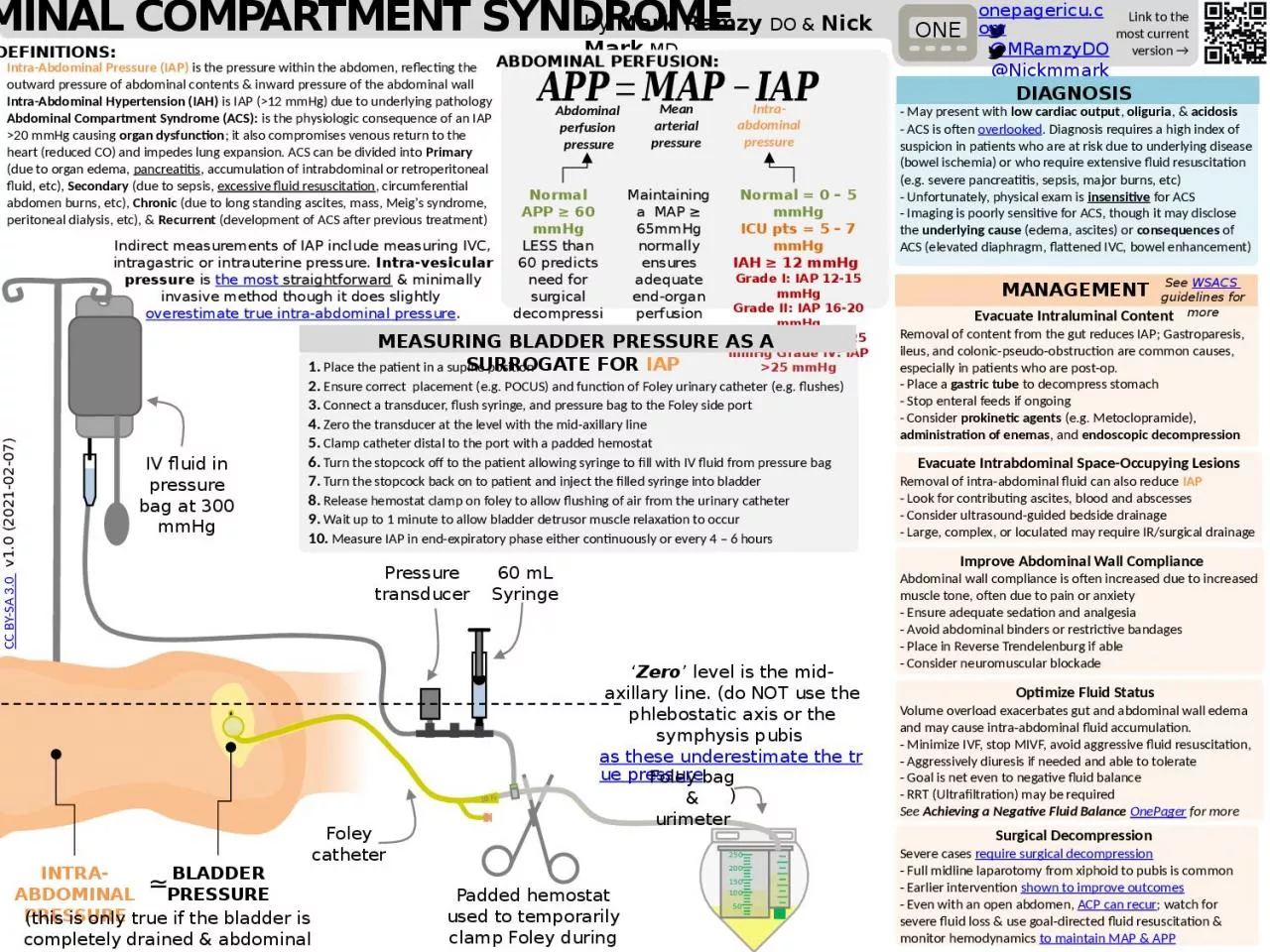

level is the midaxillary line do NOT use the phlebostatic axis or the symphysis pubis as these underestimate the true pressure IV fluid in pressure bag at 300 mmHg 60 mL Syringe 50 ID: 1007588
Download Presentation The PPT/PDF document "Pressure transducer ‘ Zero" is the property of its rightful owner. Permission is granted to download and print the materials on this web site for personal, non-commercial use only, and to display it on your personal computer provided you do not modify the materials and that you retain all copyright notices contained in the materials. By downloading content from our website, you accept the terms of this agreement.
1. Pressure transducer‘Zero’ level is the mid-axillary line. (do NOT use the phlebostatic axis or the symphysis pubis as these underestimate the true pressure)IV fluid in pressure bag at 300 mmHg60 mL Syringe50100150200250Padded hemostat used to temporarily clamp Foley during measurementFoley catheterFoley bag & urimeter18 FrIntra-Abdominal PressureBladder Pressure≃(this is only true if the bladder is completely drained & abdominal muscles relaxed)abdominal compartment syndromeLink to the most current version →ONEDEFINITIONS:by Mark Ramzy DO & Nick Mark MD Improve Abdominal Wall ComplianceAbdominal wall compliance is often increased due to increased muscle tone, often due to pain or anxiety- Ensure adequate sedation and analgesia- Avoid abdominal binders or restrictive bandages- Place in Reverse Trendelenburg if able- Consider neuromuscular blockadeOptimize Fluid StatusVolume overload exacerbates gut and abdominal wall edema and may cause intra-abdominal fluid accumulation.- Minimize IVF, stop MIVF, avoid aggressive fluid resuscitation, - Aggressively diuresis if needed and able to tolerate- Goal is net even to negative fluid balance - RRT (Ultrafiltration) may be requiredSee Achieving a Negative Fluid Balance OnePager for moreSurgical DecompressionSevere cases require surgical decompression- Full midline laparotomy from xiphoid to pubis is common- Earlier intervention shown to improve outcomes- Even with an open abdomen, ACP can recur; watch for severe fluid loss & use goal-directed fluid resuscitation & monitor hemodynamics to maintain MAP & APPEvacuate Intraluminal ContentRemoval of content from the gut reduces IAP; Gastroparesis, ileus, and colonic-pseudo-obstruction are common causes, especially in patients who are post-op.- Place a gastric tube to decompress stomach- Stop enteral feeds if ongoing- Consider prokinetic agents (e.g. Metoclopramide), administration of enemas, and endoscopic decompressionIntra-Abdominal Pressure (IAP) is the pressure within the abdomen, reflecting the outward pressure of abdominal contents & inward pressure of the abdominal wall Intra-Abdominal Hypertension (IAH) is IAP (>12 mmHg) due to underlying pathologyAbdominal Compartment Syndrome (ACS): is the physiologic consequence of an IAP >20 mmHg causing organ dysfunction; it also compromises venous return to the heart (reduced CO) and impedes lung expansion. ACS can be divided into Primary (due to organ edema, pancreatitis, accumulation of intrabdominal or retroperitoneal fluid, etc), Secondary (due to sepsis, excessive fluid resuscitation, circumferential abdomen burns, etc), Chronic (due to long standing ascites, mass, Meig’s syndrome, peritoneal dialysis, etc), & Recurrent (development of ACS after previous treatment) ABDOMINAL PERFUSION:Abdominal perfusion pressureMean arterial pressureIntra-abdominal pressureNormal APP ≥ 60 mmHgLESS than 60 predicts need for surgical decompressionMaintaining a MAP ≥ 65mmHg normally ensures adequate end-organ perfusionNormal = 0 – 5 mmHgICU pts = 5 – 7 mmHgIAH ≥ 12 mmHg Grade I: IAP 12-15 mmHgGrade II: IAP 16-20 mmHgGrade III: IAP 21-25 mmHg Grade IV: IAP >25 mmHgMEASURING BLADDER PRESSURE AS A SURROGATE FOR IAP CC BY-SA 3.0 v1.0 (2021-02-07)onepagericu.com@MRamzyDO@Nickmmark1. Place the patient in a supine position2. Ensure correct placement (e.g. POCUS) and function of Foley urinary catheter (e.g. flushes)3. Connect a transducer, flush syringe, and pressure bag to the Foley side port4. Zero the transducer at the level with the mid-axillary line 5. Clamp catheter distal to the port with a padded hemostat 6. Turn the stopcock off to the patient allowing syringe to fill with IV fluid from pressure bag7. Turn the stopcock back on to patient and inject the filled syringe into bladder8. Release hemostat clamp on foley to allow flushing of air from the urinary catheter9. Wait up to 1 minute to allow bladder detrusor muscle relaxation to occur10. Measure IAP in end-expiratory phase either continuously or every 4 – 6 hoursIndirect measurements of IAP include measuring IVC, intragastric or intrauterine pressure. Intra-vesicular pressure is the most straightforward & minimally invasive method though it does slightly overestimate true intra-abdominal pressure.DIAGNOSIS- May present with low cardiac output, oliguria, & acidosis - ACS is often overlooked. Diagnosis requires a high index of suspicion in patients who are at risk due to underlying disease (bowel ischemia) or who require extensive fluid resuscitation (e.g. severe pancreatitis, sepsis, major burns, etc)- Unfortunately, physical exam is insensitive for ACS- Imaging is poorly sensitive for ACS, though it may disclose the underlying cause (edema, ascites) or consequences of ACS (elevated diaphragm, flattened IVC, bowel enhancement) Evacuate Intrabdominal Space-Occupying LesionsRemoval of intra-abdominal fluid can also reduce IAP- Look for contributing ascites, blood and abscesses- Consider ultrasound-guided bedside drainage- Large, complex, or loculated may require IR/surgical drainageMANAGEMENTSee WSACS guidelines for more